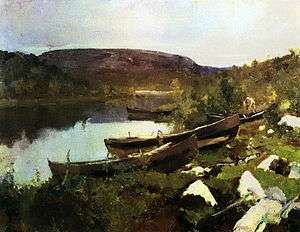Pechenga (urban-type settlement), Murmansk Oblast
| Pechenga (English) Печенга (Russian) | |
|---|---|
| - Urban-type settlement - | |
|
| |
.svg.png) Location of Murmansk Oblast in Russia | |
 Pechenga | |
|
| |
 |
|
|
| |
| Administrative status | |
| Country | Russia |
| Federal subject | Murmansk Oblast |
| Administrative district | Pechengsky District |
| Administrative center of | Pechengsky District |
| Municipal status | |
| Municipal district | Pechengsky Municipal District |
| Urban settlement | Pechenga Urban Settlement |
| Statistics | |
| Population (2010 Census) | 3,188 inhabitants[1] |
| Time zone | MSK (UTC+03:00)[2] |
| Postal code(s)[3] | 184410 |
| Dialing code(s) | +7 81554 |
| Pechenga on Wikimedia Commons | |

Pechenga (Russian: Пече́нга; Finnish and Swedish: Petsamo; Norwegian: Petsjenga; Northern Sami: Beahcán; Skolt Sami: Peäccam) is an urban locality (an urban-type settlement) in Pechengsky District, Murmansk Oblast, Russia. Municipally, it is incorporated as Pechenga Urban Settlement of Pechengsky Municipal District. Population: 3,188 (2010 Census);[1] 2,959 (2002 Census);[4] 2,671 (1989 Census).[5]
History
The Pechenga area was indigenously inhabited by the Sami people. In 1533, it became part of Russia. In 1920, the area became part of Finland. The area was ceded to the Soviet Union in 1944.
The settlement was founded as the Pechenga Monastery in 1533 at the influx of the Pechenga River into the Barents Sea, 135 km west of modern Murmansk, by St. Tryphon of Pechenga, a monk from Novgorod.
Inspired by the model of the Solovki, Tryphon wished to convert the local Sami population to Christianity and to demonstrate how faith could flourish in the most inhospitable lands. His example was eagerly followed by other Russian monks. By 1572, the Pechenga Monastery counted about 50 brethren and 200 lay followers. Six years after Tryphon's death in 1583, the wooden monastery was raided and burnt down by the Swedes. It is said that the raid claimed the lives of 51 monks and 65 lay brothers. The monastery was moved closer to the Norwegian border. It was destroyed in 1764, but restored in 1880, and exists to this day.[6]
The area was given to Finland as a result of the Treaty of Tartu and renamed Petsamo. Nickel was discovered in 1921 and began to be exploited commercially in 1935. The area was captured by the Soviets during the Winter War in 1940 but returned to Finland. During World War II Petsamo was used as a staging post for attacks on Murmansk by Finland and Germany. Aircraft from the British aircraft carrier HMS Furious attacked the port on July 30, 1941. The area was captured by the Red Army during the Petsamo–Kirkenes Offensive and incorporated into the Soviet Union after the subsequent Peace Treaty.
After the war the area was a military zone due to its proximity to the Norwegian border. Nickel mining has led to ecological problems in the area.
The 200th Independent Motor Rifle Brigade is stationed at the settlement.
References
- 1 2 Russian Federal State Statistics Service (2011). "Всероссийская перепись населения 2010 года. Том 1" [2010 All-Russian Population Census, vol. 1]. Всероссийская перепись населения 2010 года (2010 All-Russia Population Census) (in Russian). Federal State Statistics Service. Retrieved June 29, 2012.
- ↑ Правительство Российской Федерации. Федеральный закон №107-ФЗ от 3 июня 2011 г. «Об исчислении времени», в ред. Федерального закона №271-ФЗ от 03 июля 2016 г. «О внесении изменений в Федеральный закон "Об исчислении времени"». Вступил в силу по истечении шестидесяти дней после дня официального опубликования (6 августа 2011 г.). Опубликован: "Российская газета", №120, 6 июня 2011 г. (Government of the Russian Federation. Federal Law #107-FZ of June 31, 2011 On Calculating Time, as amended by the Federal Law #271-FZ of July 03, 2016 On Amending Federal Law "On Calculating Time". Effective as of after sixty days following the day of the official publication.).
- ↑ ИНФОРМАЦИЯ ОБ ОБЪЕКТЕ ПОЧТОВОЙ СВЯЗИ (in Russian). Russian Post. Retrieved 16 March 2010.
- ↑ Russian Federal State Statistics Service (May 21, 2004). "Численность населения России, субъектов Российской Федерации в составе федеральных округов, районов, городских поселений, сельских населённых пунктов – районных центров и сельских населённых пунктов с населением 3 тысячи и более человек" [Population of Russia, Its Federal Districts, Federal Subjects, Districts, Urban Localities, Rural Localities—Administrative Centers, and Rural Localities with Population of Over 3,000] (XLS). Всероссийская перепись населения 2002 года [All-Russia Population Census of 2002] (in Russian). Retrieved August 9, 2014.
- ↑ Demoscope Weekly (1989). "Всесоюзная перепись населения 1989 г. Численность наличного населения союзных и автономных республик, автономных областей и округов, краёв, областей, районов, городских поселений и сёл-райцентров" [All Union Population Census of 1989: Present Population of Union and Autonomous Republics, Autonomous Oblasts and Okrugs, Krais, Oblasts, Districts, Urban Settlements, and Villages Serving as District Administrative Centers]. Всесоюзная перепись населения 1989 года [All-Union Population Census of 1989] (in Russian). Институт демографии Национального исследовательского университета: Высшая школа экономики [Institute of Demography at the National Research University: Higher School of Economics]. Retrieved August 9, 2014.
- ↑ http://www.roca.org/OA/90/90h.htm